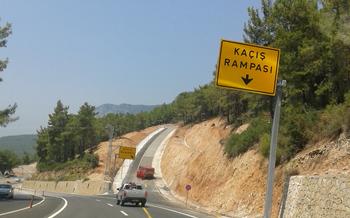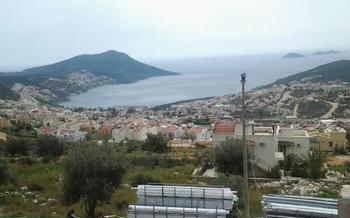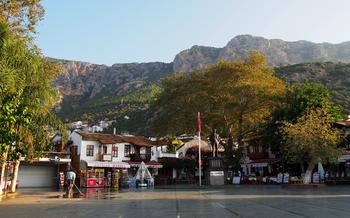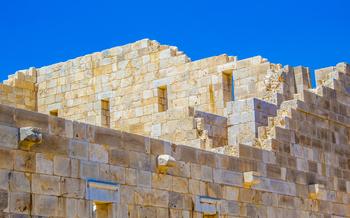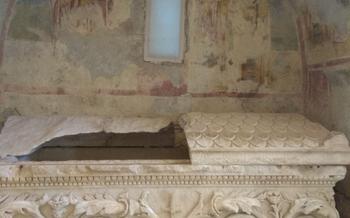
Patara Amphitheatre
- Exploring the Historical Significance of Patara Amphitheater
- Architectural Marvel
- Seating and Capacity
- Gladiatorial Contests
- Entertainment and Performances
- Religious Ceremonies:
- Restoration and Preservation
- Visiting the Amphitheater
- Photography Opportunities:
- Accessibility and Facilities
- Local Customs and Etiquette
- Off-season Charm
- Local Cuisine and Delicacies
- Unique Souvenirs and Handicrafts
- Insider Tip: Sunset Magic
Exploring the Historical Significance of Patara Amphitheater
Journey back in time to the ancient city of Patara, where the Patara Amphitheater stands as a testament to its rich history and cultural significance. Once a bustling hub of entertainment and spectacle, this impressive structure played a pivotal role in the lives of Patara's inhabitants.
As you step through the gates of the amphitheater, imagine the roar of the crowd echoing through the stone tiers as gladiators engaged in fierce battles for survival. The amphitheater's design reflects the influence of Roman engineering, with its carefully crafted seating arrangement and intricate acoustics that ensured every spectator had a clear view and could hear the performers.
Delve into the history of Patara, founded by the Lycians, a seafaring people who established a powerful league of cities. The amphitheater served as a central gathering place for these city-states, hosting not only gladiatorial contests but also theatrical productions, musical concerts, and religious ceremonies.
Archaeological excavations at the site have unearthed a treasure trove of artifacts, shedding light on the daily lives and customs of Patara's ancient residents. Discover the secrets of this fascinating city as you explore the amphitheater's well-preserved remains, transporting you back to a time of drama, excitement, and historical significance.
Architectural Marvel
The Patara Amphitheater stands as a testament to the architectural prowess of the ancient world. Its well-preserved seating tiers, intricate carvings, and impressive engineering feats are a sight to behold. The amphitheater's facade is adorned with intricate details, including decorative moldings, friezes, and sculptures that depict scenes from mythology and everyday life.
Inside the amphitheater, the seating tiers rise in concentric circles, providing spectators with different viewing angles. The VIP seating areas, located closest to the stage, were reserved for prominent figures and officials. These seats were often adorned with elaborate decorations and cushions, ensuring the comfort of the city's elite.
The amphitheater's engineering is equally impressive. The structure was built without the use of mortar, relying instead on the careful interlocking of massive stone blocks. This technique allowed the amphitheater to withstand earthquakes and other natural disasters, ensuring its survival for centuries.
The acoustics of the theater are also remarkable. The design of the seating tiers and the curved shape of the stage create a natural amplification system that allows performers to be heard clearly throughout the venue. This acoustic marvel contributed to the amphitheater's popularity as a venue for theatrical productions, musical concerts, and other performances.
Seating and Capacity
Imagine yourself amidst the lively atmosphere of ancient Patara, where approximately 5,000 spectators eagerly await the start of a gripping performance. The amphitheater's seating arrangement is a testament to the social hierarchy of the time. The lower tiers, closest to the stage, were reserved for prominent figures and officials, ensuring they had the best views and proximity to the action. As you ascend the tiers, you'll notice the seating gradually transitions to accommodate the general public. This tiered arrangement not only provided different viewing experiences but also reflected the social stratification that existed within the ancient city.
Explore the backstage areas, where performers and gladiators prepared for their appearances. These spaces, often overlooked by visitors, offer a glimpse into the behind-the-scenes workings of the amphitheater. Imagine gladiators donning their armor, actors rehearsing their lines, and musicians tuning their instruments in these very rooms. These areas add depth to your understanding of the amphitheater's significance and the lives of those who brought it to life.
Gladiatorial Contests
Immerse yourself in the brutal and captivating history of gladiatorial contests that took place within the Patara Amphitheater. These events were a staple of Roman entertainment, showcasing the prowess and skill of trained fighters. Imagine the roar of the crowd as gladiators, armed with swords, shields, and nets, battled for their lives in the arena. Learn about the different types of gladiators, from the heavily armored legionaries to the agile retiarii, each with their own unique fighting style. Discover the training methods and weapons used by these gladiators as they prepared for the deadly spectacles that awaited them in the amphitheater.
Reflect on the ethical implications of these contests, which often resulted in bloodshed and death. While they were seen as a form of entertainment, they also raised questions about the value of human life and the glorification of violence. Understand how the popularity of gladiatorial contests eventually declined in the Roman Empire, due to a combination of moral objections, financial constraints, and the rise of Christianity.
Entertainment and Performances
The Patara Amphitheater was not just a venue for gladiatorial contests; it also hosted a wide range of other performances that captivated audiences and enriched the cultural life of the city. Imagine the excitement and anticipation as the ancient theater came alive with the sounds of music, laughter, and applause.
The amphitheater's stage played host to theatrical productions that transported audiences to faraway lands and legendary tales. Actors adorned in elaborate costumes brought myths and historical events to life, immersing spectators in a world of drama, tragedy, and comedy.
Musical concerts filled the air with enchanting melodies, as skilled musicians strummed lyres, plucked harps, and blew trumpets. The acoustics of the theater ensured that every note resonated throughout the venue, creating an immersive auditory experience for all.
Acrobatic displays showcased the incredible skill and agility of performers who defied gravity and amazed onlookers with their daring feats. Balancing acts, tumbling routines, and human pyramids thrilled the crowd, leaving them in awe of the performers' athleticism and artistry.
Religious Ceremonies:
Beyond gladiatorial contests and entertainment, the Patara Amphitheater held profound religious significance. The ancient city of Patara was a center of religious activity, honoring various deities through rituals and ceremonies within the amphitheater's sacred space. Imagine the solemn atmosphere as participants gathered for religious observances, seeking blessings and paying homage to their gods.
The amphitheater served as a venue for religious festivals, where communities celebrated their beliefs and traditions. Participants engaged in sacred rituals, performed devotional dances, and offered sacrifices to honor their chosen deities. The amphitheater's unique acoustics enhanced the spiritual experience, allowing the voices of priests and celebrants to resonate throughout the venue, creating a sense of awe and devotion.
Explore the unique blend of Roman and local religious traditions that influenced the amphitheater's use. While gladiatorial contests were a Roman spectacle, the amphitheater also hosted religious ceremonies rooted in the indigenous beliefs of the Lycian people. This fusion of cultures resulted in a rich tapestry of religious practices that added depth and meaning to the amphitheater's history.
Reflect on the significance of these religious ceremonies in shaping the spiritual and cultural life of Patara. The amphitheater was not just a place of entertainment but a sacred space where communities came together to honor their beliefs, celebrate their traditions, and seek divine favor.
Restoration and Preservation
The Patara Amphitheater has undergone extensive restoration and preservation efforts to ensure its longevity and accessibility for future generations. These endeavors have been meticulously carried out to maintain the integrity of the ancient structure while enhancing its functionality and safety. Archaeological excavations have played a crucial role in uncovering valuable artifacts, shedding light on the amphitheater's rich history and significance. Ongoing research and conservation work continue to contribute to our understanding of this remarkable site, preserving its legacy for years to come. By safeguarding and restoring the Patara Amphitheater, we honor the cultural heritage of this region and ensure that future visitors can continue to marvel at its grandeur and historical significance.
Visiting the Amphitheater
To make the most of your visit to the Patara Amphitheater, it's essential to plan ahead. Check the opening hours and admission fees before your trip to ensure you have ample time to explore the site. Combine your visit with other nearby attractions, such as the Patara Beach, known for its pristine waters and stunning views, and the Xanthos ruins, an ancient city with well-preserved Lycian tombs and monuments. If you're interested in delving deeper into the history and significance of the amphitheater, consider joining a guided tour. Knowledgeable guides can provide insights into the amphitheater's construction, events, and cultural significance, enhancing your overall experience.
Photography Opportunities:
The Patara Amphitheater presents a wealth of photographic opportunities for enthusiasts of all skill levels. Capture the amphitheater's imposing architecture against the backdrop of the azure sky or the golden hues of dawn and dusk. Experiment with different angles to showcase its grandeur, from sweeping panoramas to intimate close-ups of intricate carvings. Take advantage of the soft, diffused light of the golden hour to create warm and vibrant shots of the amphitheater's exterior, making its stones glow with an ethereal radiance. Share your captivating photographs online to inspire others to embark on their own journey of discovery to this historical gem.
Accessibility and Facilities
Understanding Accessibility Options: The Patara Amphitheater strives to provide an inclusive experience for all visitors, including those with disabilities or limited mobility. Accessibility options are available to ensure that everyone can explore this historical site with ease and comfort.
Restrooms, Seating, and Designated Paths: Accessible restrooms are available within the amphitheater complex, ensuring convenience for visitors with special needs. Designated seating areas are also provided for individuals requiring additional support during performances or events. Additionally, ramps and designated paths allow for smooth and safe navigation throughout the site.
Visitor Center and Information Points: The visitor center serves as a valuable resource for visitors seeking information about the amphitheater and its history. Here, you can obtain maps, guides, and other resources in accessible formats. Knowledgeable staff members are also available to assist with any inquiries or provide additional information.
Explore Nearby Amenities: To enhance your overall experience, explore the dining options and transportation services available near the amphitheater. Restaurants offering a variety of cuisines are within easy reach, catering to different dietary preferences. Additionally, transportation services, including accessible options, are available to facilitate your visit and ensure a seamless journey to and from the site.
Local Customs and Etiquette
When visiting the Patara Amphitheater, it is essential to be respectful of local customs and traditions. Dress appropriately, avoiding revealing or disrespectful attire. This is especially important when visiting religious sites or conservative areas. Be mindful of noise levels and avoid disturbing other visitors or ongoing performances. Follow any guidelines or instructions provided by the site's management or tour guides. Remember that the Patara Amphitheater is a historical and cultural landmark, and it is essential to treat it with respect and preserve its integrity for future generations.
Off-season Charm
While the summer months offer a vibrant and bustling atmosphere, the off-season (November to April) holds a unique charm for those seeking a more intimate and serene experience at the Patara Amphitheater. During this time, the crowds thin, allowing you to wander through the ancient ruins at your own pace, capturing stunning photographs without the throngs of tourists. The cooler weather provides a comfortable climate for exploration, making it an ideal time to delve into the history and significance of this remarkable site. Embrace the slower pace of life in Patara during the off-season, immersing yourself in the local culture and traditions. Discover the town's hidden gems, engage with friendly locals, and enjoy the tranquility of this ancient land without the summer's hustle and bustle.
Local Cuisine and Delicacies
Indulge in the culinary delights of Kalkan and the surrounding region to enhance your visit to the Patara Amphitheater. Savor the freshness of seafood dishes, prepared with the daily catch from the Mediterranean Sea. Delight in traditional Turkish mezes, an array of small plates featuring tantalizing flavors and textures. Don't miss the mouthwatering desserts, showcasing the region's rich culinary heritage.
Explore local markets and shops to discover unique flavors and culinary treasures. Engage with friendly vendors and learn about the local ingredients and cooking techniques that make the region's cuisine so special. Whether you prefer to dine at charming restaurants overlooking the Mediterranean Sea or savor street food delicacies, you'll find culinary experiences to satisfy every palate.
Unique Souvenirs and Handicrafts
Immerse Yourself in Local Culture and Craftsmanship
As you explore the charming town of Kalkan, don't miss the opportunity to shop for unique souvenirs and handicrafts that reflect the rich cultural heritage of the region. Discover handmade pottery adorned with intricate patterns, inspired by ancient Lycian designs. Admire the vibrant colors and intricate motifs of handwoven textiles, each piece a testament to the skill of local artisans. Browse through a treasure trove of traditional jewelry, crafted with silver, gold, and semi-precious stones, drawing inspiration from centuries-old designs.
Support local artists and craftsmen by purchasing their creations, ensuring that traditional techniques and skills continue to thrive. Bring home a piece of Patara's history and craftsmanship, a unique souvenir that will serve as a lasting reminder of your visit to this enchanting town.
Insider Tip: Sunset Magic
To fully immerse yourself in the grandeur and beauty of the Patara Amphitheater, plan your visit to coincide with sunset. As the sun gradually descends below the horizon, the ancient stones of the amphitheater are bathed in a warm golden glow, creating a magical and ethereal atmosphere. Capture breathtaking photographs of the amphitheater's majestic silhouette against the backdrop of the vibrant sky. The soft evening light casts intricate shadows and highlights the architectural details of the structure, revealing its timeless beauty. Experience a moment of tranquility as you sit in the ancient seats and soak in the serenity of the surroundings. With the stars twinkling above and the gentle sea breeze caressing your face, you'll feel transported back in time, immersed in the history and wonder of this remarkable place.
